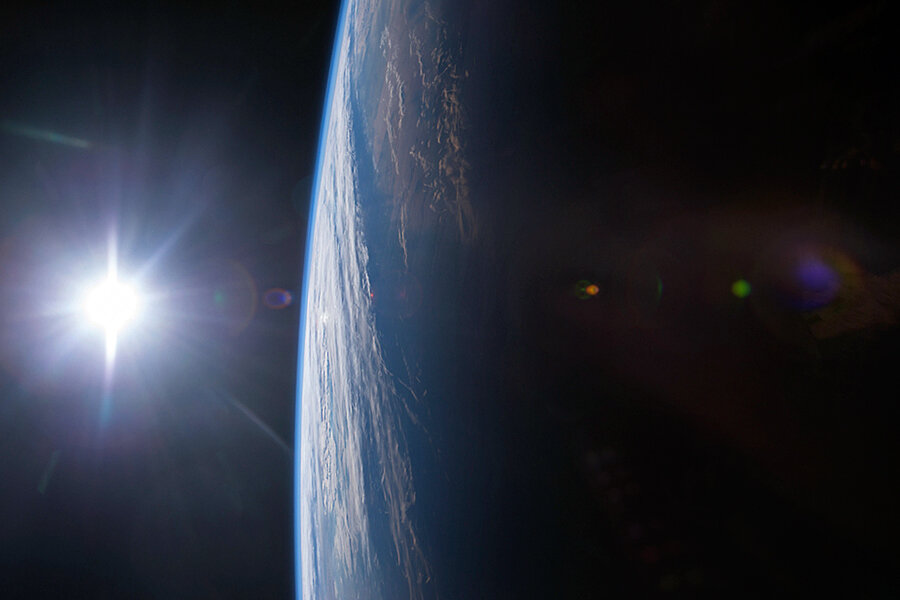Hunt for other Earths just got a bit more sophisticated
Loading...
Two new studies could help scientists narrow the search for planets capable of hosting life.
One has come up with a recipe that posits which planets should have an Earth-like composition – suggesting they should be relatively common. The second offers estimates of how long it would take oceans to form on planets roughly the same mass as Earth.
By focusing on factors that contribute to a planet's habitability, both studies go to "the very heart of why we're looking for exoplanets," said Debra Fischer, a Yale University astronomer and veteran planet hunter, during a briefing Monday at the American Astronomical Society's winter meeting in Seattle.
The "really amazing and impressive work" shows how far the study of solar systems beyond our own has come in the 20 years since the first extrasolar planet was discovered, said Dr. Fischer, who was not a member of either team.
Once confined merely to counting planets and getting estimates of their sizes and masses, researchers are now working to understand the makeup of alien worlds, whether they are habitable, and what they may teach about the evolution of our own solar system, she said.
The first study looked at determining the composition of a planet, which is crucial to determining its potential habitability. To determine composition, scientists take clues from a planet's density. For example, inhospitable gas giants are comparatively less dense, being largely gas. Yet even among denser rocky planets, compositions can vary. Finding an Earth-like mix could help find a habitable Earth-like planet.
Harvard University graduate student Courtney Dressing, along with an international team of colleagues, looked at models of how the ratio of planet masses and sizes changes for different compositions – from 100 percent water to 100 percent iron. The conclusion: If you see a dense extrasolar planet with masses between one and six times Earth's mass, it's highly likely to have a similar composition to Earth in at least one important way: the same relative abundance of magnesium silicate and iron.
Exhibit A: Kepler 93b, a planet about 1.5 times larger and 4 times more massive than Earth. It is the seventh Earth-scale planet researchers have measured in detail for mass, size, and density. It fell neatly into place among the mass-to-radius ratios of Venus, Earth, and four other extrasolar planets more massive than Earth -- arranged along a line of successively larger rocky planets with similar proportions of magnesium silicate and iron.
To be sure, Kepler 93b is not in its star's habitable zone – the place where water can remain stable on a planet's surface. Orbiting only 4.7 million miles from its star, Kepler 93b is decidedly inhospitable.
Still, "we do find a recipe that fits all those planets," Ms. Dressing said – one that almost sounds like something out of a junior high school science fair project. The recipe (scaled proportions): 1 cup magnesium, 1 cup of silicon, 2 cups of iron, 2 cups of oxygen, 1/2 teaspoon of aluminum, nickel, and calcium, 1/4 teaspoon of sulfur, and a dash of water, typically delivered by asteroids smacking into the budding planet.
The second study looks more closely at the "dash" of water – what it takes for planets to form and maintain oceans on their surfaces. Its findings suggest that if you're hunting for a habitable world with oceans, look for an older planet somewhat more massive than Earth, according to Laura Schaefer, a researcher at the Harvard-Smithsonian Center for Astrophysics in Cambridge, Mass.
That analysis is tied to an assumption by the researchers: that rocky planets with oceans should, like Earth, recycle their rocky crust through plate tectonics. On Earth, some plates of the Earth's crust are forced down into the interior of the planet along trenches in what are are called subduction zones.
This cycle also carries ocean water deep beneath the crust. The water in the subducting slabs gets mixed in with magma, some of which is released as the magma wells up to form new crust at mid-ocean ridges -- a process called outgassing.
In Earth's case, the planet is thought to hold between one and 10 times more water beneath its crust than in surface oceans.
Dr. Schaefer's team used models simulating tectonic conditions for rocky planets of various masses:
- For those five to six times Earth's mass, team found that oceans likely begin forming about 1 billion years after the planet forms. Oceans would initially be shallower than those on smaller planets, but those oceans would build over time as outgassing increased, said Schaefer, who performed the analysis with colleague Dimitar Sasselov.
- For planets between two and four times Earth's mass, outgassing would begin quickly. The oceans would shrink over time, but they would persist through the life of the planet.
- On planets less than Earth's mass – think Venus, for example – "they release all their heat to the surface" quickly, and "as they do that, the water that was originally on the surface becomes trapped in the interior," Schaefer said.
Having a sense of a planet's age will be crucial for figuring out where a planet's likely inventory of water lies, with the older ones more likely candidates for surface oceans, Schaefer added.








